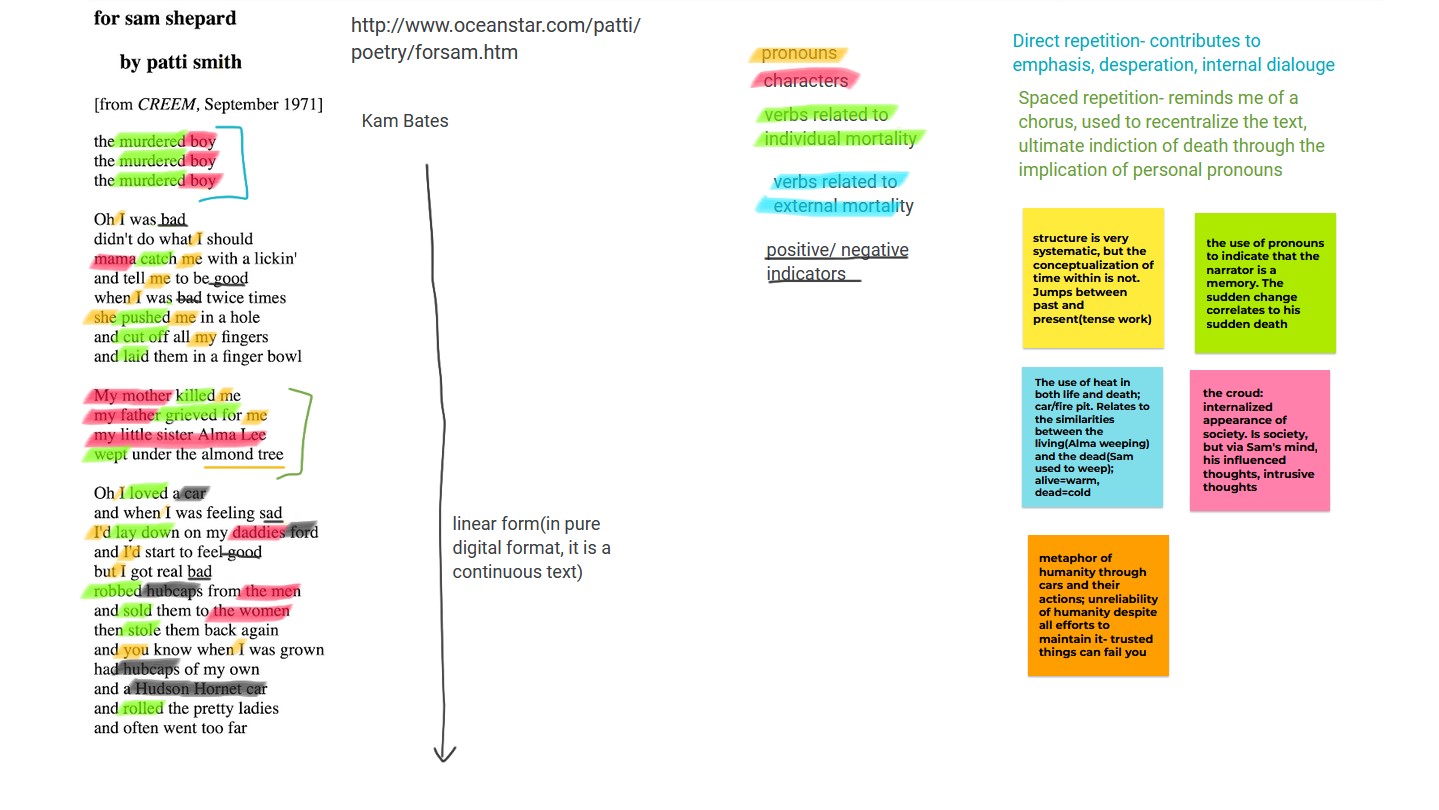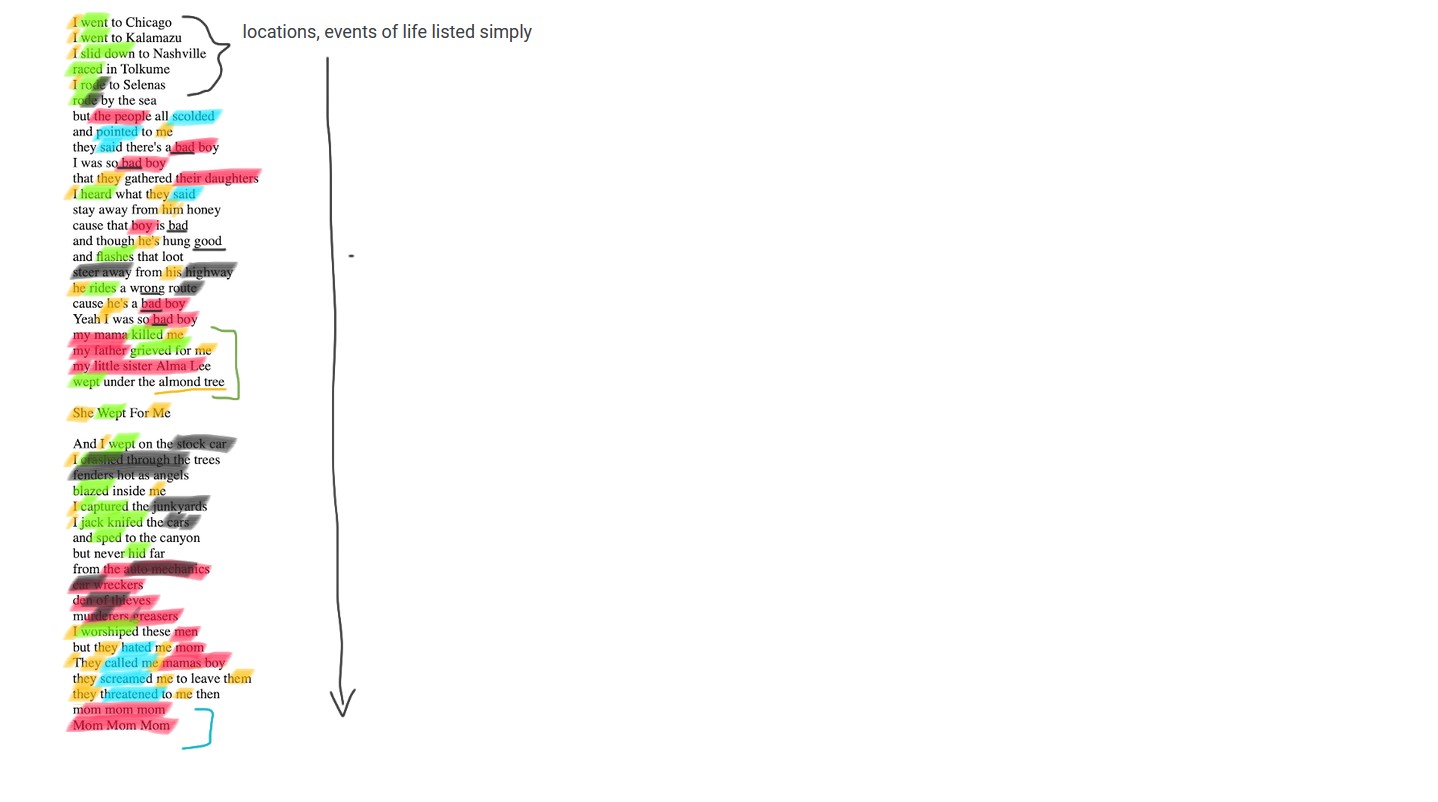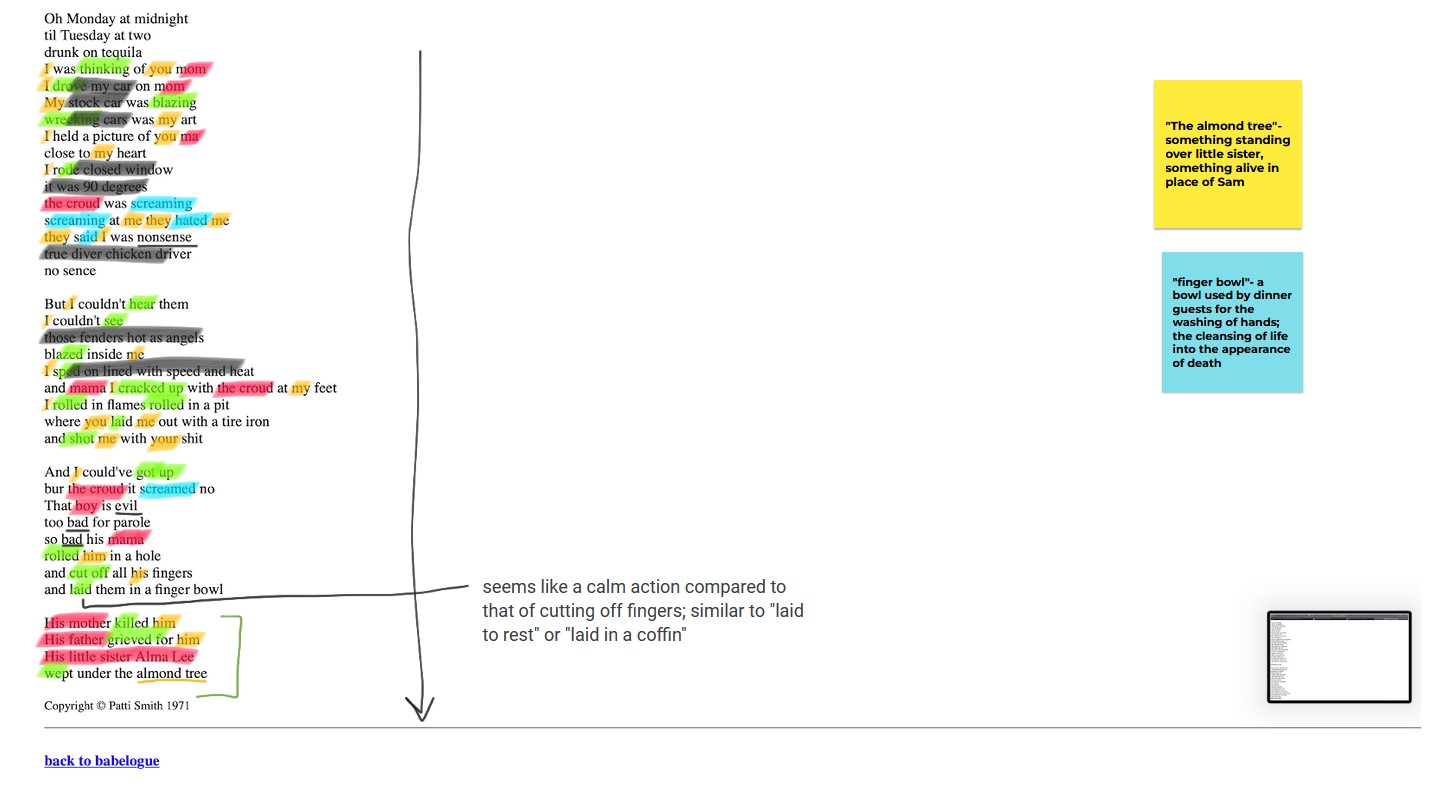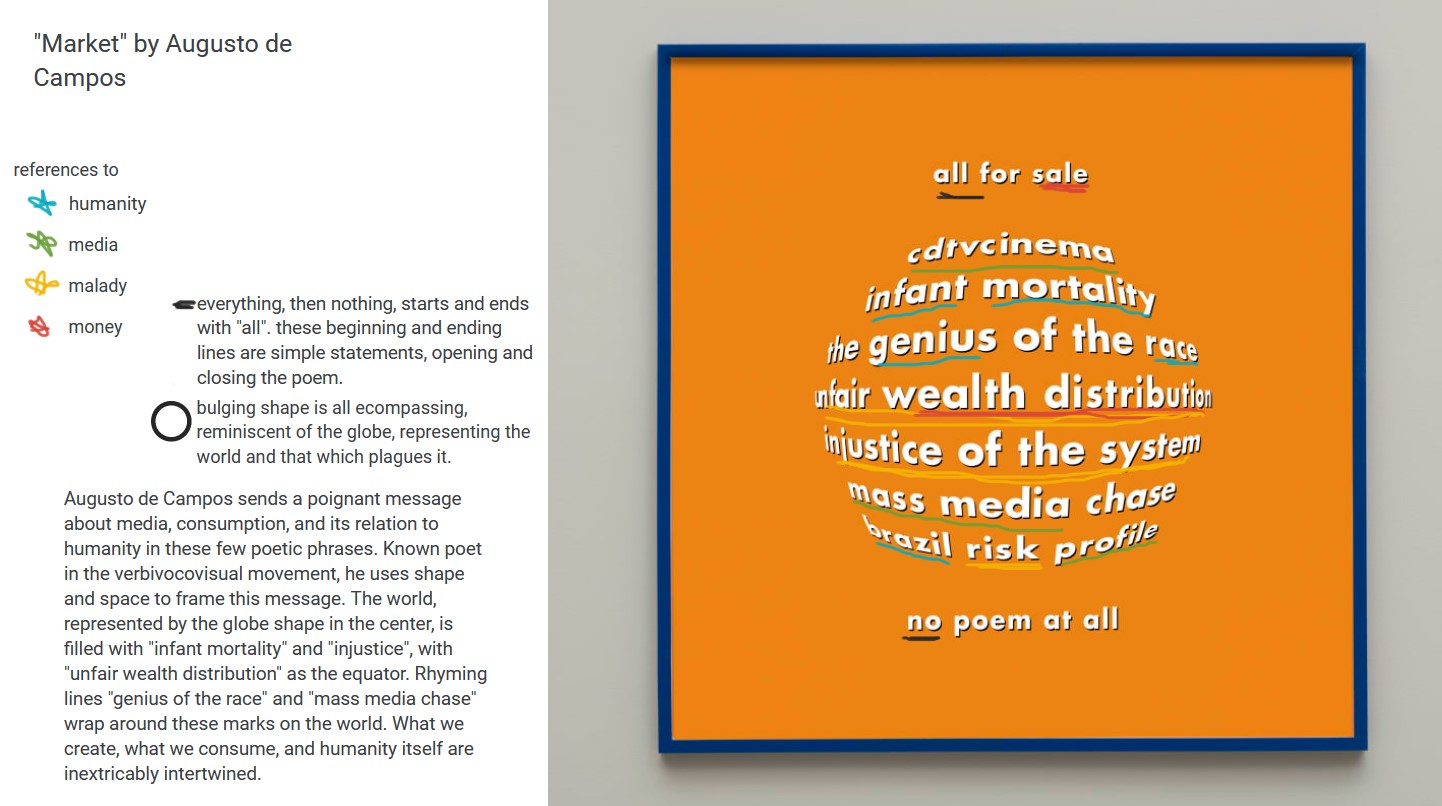Kamryn Bates, Dennis Olmedo, Basil Perun, Mary Yuen
Group Seven: Humanity in Code
Central Question: How might we ascribe meaning to poetry as an expression of humanity relative to its coded form?
For Sam Shepard by Patti Smith
The poem “For Sam Shepard” by Patti Smith serves as a remembrance piece for the author’s life-long friend. Though the graphic details of the poem do not apply to Sam Shepard's reality, the ultimate finale in both reality and literature is death and grief. This portrayal of inevitable mortality in this work is achieved through the use of repetition, emotional verb phrases, and an automated metaphor regarding the unreliability of humanity. The coded form of the poem is represented linearly, similar to the progression of life, though the conceptualization of time within the poem is not. Though the poem was originally printed in CREEM magazine, the digital form is intentional and contributes to the contrast between form and time conveyed by the work. These themes of mortality and humanity evolve within the additional poems in this selection. Langston Hughes’ “The Weary Blues” has a similar linear fluidity surrounding time while also introducing themes of death throughout. In “Market” by Augusto De Campos, the poet conveys the relation of capitalistic ideals to humanity and, therefore, our inevitable expiration. The structural elements of “Terremoto” by Augusto De Campos allow for the expression of humanity through the lens of natural occurrences and phenomena, while maintaining a slightly more linear expression of time. This collection of poems, through each uniquely intricate, communicates integral components of humanity through literary and structural form.



Market by Augusto de Campos
Brazilian poet Augusto de Campos sends a poignant message about media and its relation to humanity in a simple, yet striking visual manner. A founder of the Concrete poetry movement, de Campos uses shape and space to frame this message. The world, represented by the globe shape in the center, is filled with "infant mortality" and "injustice", with "unfair wealth distribution" as the equator. These issues plague our society, yet also serve as a defining structure and "necessary evil" in a world that depends on consumption above all else. Rhyming lines "genius of the race" and "mass media chase" lie above and below the "equator", respectively. Mankind's intellectual achievements may be admirable, but are ultimately repackaged to become palatable.. It starts with "all for sale", but at the end, there is "no poem at all"; thought loses meaning as it is distilled through the lens of lucrative media marketing. What we create, what we consume, and humanity itself are inextricably intertwined.
Editorial decisions were based on ties to themes of humanity, media, malady, and money. Most of the poem's phrases can fall into one or more of these categories. Upon first glance, "Market" reads as a bulbous mashup of words, most of them with a negative connotation. Grouping them together helps make sense of the madness and encourage the reader to make thematical connections. Is humanity survived through its creations? How do these creations change when marketed for the widest audience possible? Is a society driven by capitalizing on creation, obsessed with moneymaking, only do more harm than good? These are some leading questions to keep in mind when approaching this poem.

The Weary Blues By Langston Hughes
This piece of literature I can only see as one thing. Man is walking down the street (presumably Langston himself), hears a man almost half-asleep humming a tune who then started playing his piano and sort of just go in this state of like trance. The man listens to what the other man was playing and was impressed at the performance he received. That’s pretty much it for this guy.
Our central question/idea was about the repetitious and predictable nature of mortality/humanity, and we were looking to see how this theme is conveyed through form/code and vervibocovisual aspects, how can we use code to make the connections between language, visuals and sound and how might we ascribe meaning to poetry (as an expression of humanity) when it is digitized.
The Weary Blues conveys this feeling of the nature of mortality/humanity with the “artist” character who is playing the piano singing “The Weary Blues”, singing with a deep voice with a tune of melancholy, making the piano “moan” so it sounded like very sad and emotional.
With code I feel like having music play in the background (maybe just instrumental like The Weary Blues, maybe there is an actual rendition that could be used) the use of dark colors for the text and maybe an image of a shrouded character playing a piano.

terremoto by Augusto de Campos
Here, de Campos summarizes human life, experiences and death into a sequence of 4 stanzas, 15 words and 10 letters. Despite its minimalism, “terremoto” conveys several layers of meaning, all connected, through its creative combination of form and language.
The verbal form of “terremoto” portrays humanity and mortality in a fairly abstract way, using themes of written language, natural and human-made environments, and disaster. The contrasting imagery of the sun and stars in stanza 2 and the earthquake in stanza 3 can represent the instability of nature, but it can also represent the contrast between the innocence of childhood and the fear and uncertainty of adulthood. References to the building blocks of language could represent both the minimalism of the poem itself and the development of the human mind - from the simplicity of letters to the complexity of words. The earthquake destroying the subway could be a literal disaster representing the unpredictability of death or a metaphor for the terror of mortality. The “crooked engine” could be a wrecked subway train, or a mortally wounded body. The poem also makes use of wordplay: “termo” is Portuguese for both “word” (or term) and “end”, referring to its themes of both language and mortality. Its references to death can represent either literal death or the death of innocence that comes with adulthood - both important parts of the human experience.
The poem’s visual structure, with its clusters of intersecting words, contributes to its message in its own way. The intersecting lines could represent a map of the subway or the cracks in the ground from the earthquake. The stanza progression, first growing then shrinking in size, could represent human growth and death, or the buildup and dissipation of an earthquake. Like the verbal aspect, the visual aspect communicates multiple meanings at once.
This poem reminds me of code in that it uses simple, organized language to create a complicated story, much like how code uses simple, organized rules to create a complicated process. To reflect this, I’ve transcribed “terremoto” into a digital form to analyze it. Notably, “terremoto” was originally printed in black-on-white and then white-on-blue. De Campos has also said that white-on-black might work. What effect might each of these color schemes have on the reading experience? In a digital format, one might be able to answer this question much more easily by quickly switching between the colors.
